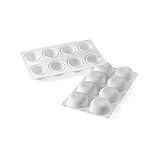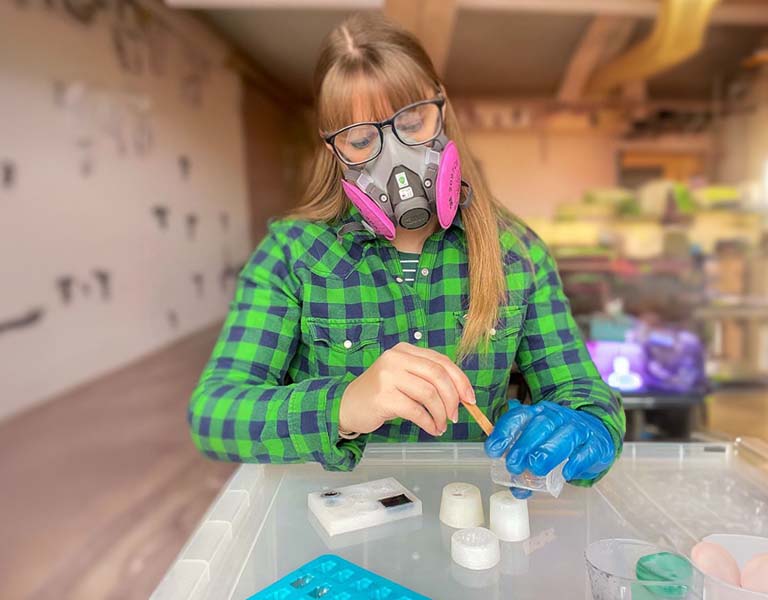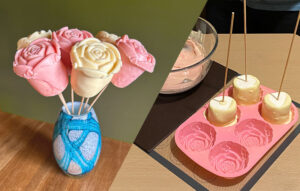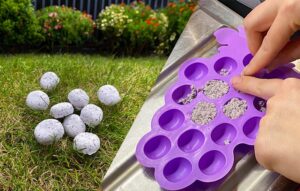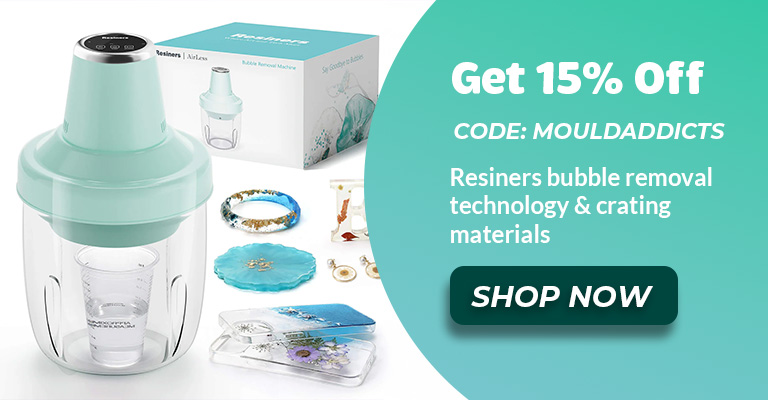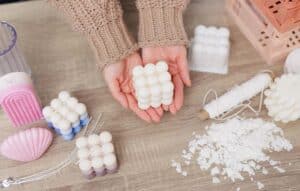I’m going to share my best tips and tricks for working with clay and silicone molds—from choosing the right clay for silicone molds to making sure nothing gets stuck (because, let’s be real, we’ve all had that happen).
By the end, you’ll be ready to take your clay crafting to a whole new level. Let’s get into it.
What is the Best Clay for Silicone Molds?
Alright, let’s talk clay for silicone molds. Not all clays are created equal, especially when it comes to using them with silicone molds. You’ve got options—polymer clay, air-dry clay, ceramic clay—but which one is the right pick for your project?
It all depends on what you’re aiming for and how you want the final piece to feel and look.
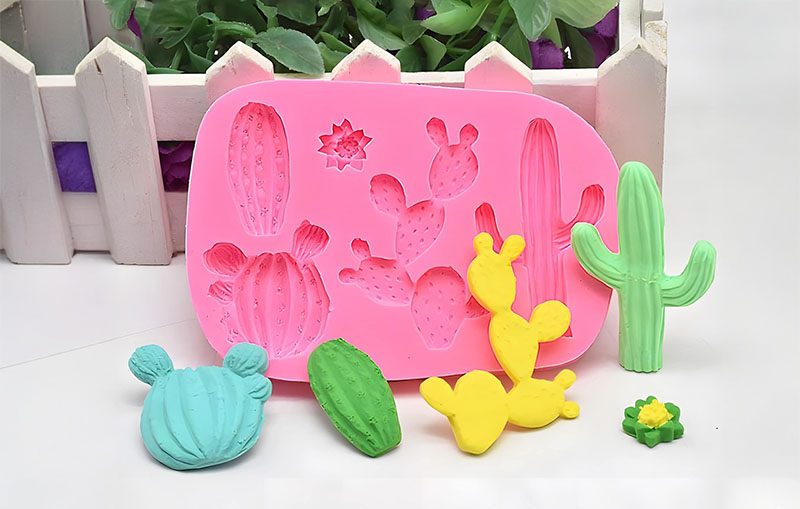
Polymer Clay for Silicone Molds
A perfect clay for silicone molds. It’s super popular, easy to shape and keeps those crisp details after baking. Plus, it doesn’t shrink, so what you see is what you get—no surprises.
It’s great if you want durable pieces like jewelry or small sculptures, like these cute polymer clay dragons.
- Pros: Easy to work with, holds fine details beautifully, and doesn’t shrink when it cures. It’s also available in tons of vibrant colors, so you can get creative without worrying about painting afterward. Plus, it stays soft until you bake it, so you can take your time adjusting your piece.
- Cons: It can be a little tricky to remove from more intricate molds without a bit of patience. And because it needs to be baked, you’ll need an oven or toaster handy.
- Best Brands: I love Sculpey Premo and FIMO Professional for their great range of colors and their durability after baking. Cernit is another solid option if you want a translucent, glass-like finish.
- CREATE WITH CLAY – The 30-piece sampler set of STAEDTLER FIMO Soft polymer clay is perfect for modeling, sculpting, and creative expression in arts and crafts. Perfect for beginners crafters and…
- BLENDABLE & PLIABLE – This soft, non-toxic polymer clay formula allows for easy shaping for detailed sculpting, effortless mixing of colors, and smooth finishes after baking
- WHITE POLYMER CLAY SET – FIMO Soft is a non-toxic sculpting clay thats infinitely versatile for endless art and crafts. Easy to open, 1 pound, (454 g) pack is divided into 8 portions for easy…
- NO KILN NEEDED – No special equiptment is needed to preserve your clay creations! FIMO Soft remains pliable until baked in any oven at 230F for 30 minutes. Once hardened, you can paint, varnish, sand,…
- STAYS SOFT UNTIL BAKED: Does not air dry. Remains soft and flexible until it is baked in your home oven – No kiln needed. Store extra clay to use later.
- FUN TO PAINT & FINISH: After baking, it can be sanded, drilled, carved and painted with water-based acrylic paints. Create endless works of art. Ideal for all skill levels.
- SCULPEY III is a great introduction to oven-bake clay because it is soft and easy to use. Non-drying flexible formula. Great for a variety of projects such as: jewelry, DIY home décor, mixed media…
- 1 OUNCE BARS: The ideal size for sampling multiple colors. These options are also great for sharing, so you can get everyone in on the crafting fun!
Air-Dry Clay for Silicone Molds
A clay for silicone molds which is great if you’re looking for a more organic feel without the need for baking. It’s also less expensive, which is a bonus if you’re experimenting.
But keep in mind, it can be a bit tricky since it shrinks as it dries. Just be sure to pick a mold with a little wiggle room for that.
- Pros: Don’t need any special equipment—just shape it, mold it, and let it dry. It’s also pretty forgiving, which makes it perfect if you’re just starting out or testing new designs. It’s lightweight, too, so it’s great for projects like ornaments or larger decor pieces.
- Cons: It can shrink as it dries, which sometimes causes it to pull away from the mold or crack if the mold is too detailed. It’s also not as durable as polymer clay unless you seal it well, so it might not hold up for pieces that need to be handled a lot.
- Best Brands: For air-dry clay, Crayola Model Magic is great for beginners, while Das Air-Dry Clay offers a more professional finish. Hearty Clay is another favorite if you’re looking for a super lightweight, smooth option.
- MODEL MAGIC VARIETY PACK: The Crayola Model Magic Deluxe Variety Pack features 14 vibrant colors of air-dry clay alternative.
- AIR DRY CLAY ALTERNATIVE: This non-toxic, quick-drying modeling material reduces waiting time, making crafting and sculpting more fun and engaging. No kiln needed!
- A super workable, ultra light weight, soft polymer air dry clay; very easy to work with, exceptionally versatile and very elastic for professional results
- Great for intricate, detailed and delicate work; jewelry making, flowers, miniatures, dolls and embellishments. Works great with all push molds.
Ceramic clay
Your go-to if you want to get into pottery or make pieces that are more delicate and traditional. It’s ideal for larger projects, but it needs to be fired in a kiln, so it’s a bit more of a commitment.
It’s definitely worth it for those timeless, high-quality finishes, though.
- Pros: If you’re looking to create something truly long-lasting and want that classic pottery feel, ceramic clay is where it’s at. It’s ideal for larger, more substantial pieces and holds intricate details really well. Once fired, it’s super durable and can be glazed for a beautiful finish.
- Cons: This one’s definitely for the more serious crafters since it requires access to a kiln. It also needs a bit of extra work when it comes to drying and firing to prevent cracking, but the results are totally worth it.
- Best Brands: Laguna and Amaco make some excellent stoneware and porcelain clays that work well with detailed silicone molds. If you’re just starting and looking for a clay that’s a little more forgiving, try Amaco Air-Dry Plus—it’s not quite the same as kiln-fired clay but still gives you a feel for the medium.
So, which one is the best clay for silicone molds? Honestly, it comes down to what you’re making and your vibe. If you’re all about clean details and vibrant colors, polymer clay might be your best friend. If you’re into a more natural, handmade look, give air-dry clay a shot. And if you’re ready to go all-in, ceramic clay could be the perfect fit.
- Cone: 5
- Speckled Buff falls into the tan/brown color range. Oxidation ( First Image), Reduction ( Second Image).
How do you keep clay from sticking to silicone molds?
So, a pain point — there’s nothing worse than carefully pressing your clay into a silicone mold, only to have it stubbornly refuse to come out. However, there are ways to avoid it! and save yourself a ton of frustration!
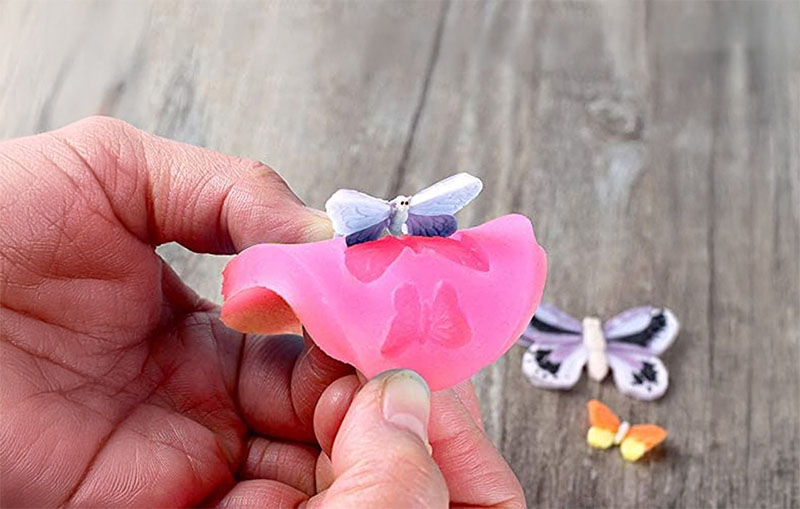
1. Use a Release Agent
This is the easiest way to ensure your clay pops out of the mold without a fuss. A light dusting of cornstarch or baby powder goes a long way in reducing the stickiness.
Just sprinkle a bit into the mold, tap out the excess, and press in your clay. If you’re working with polymer clay, a little bit of water or rubbing alcohol can also work wonders.
And for those trickier molds, a light coat of Mold Release Spray can make all the difference—just don’t overdo it, or it might affect the finish of your piece.
2. Chill Your Clay
This one’s a hack, especially if you’re working with polymer clay. Just pop your mold (with the clay in it) into the freezer for about 10-15 minutes.
The cold makes the clay firm up, so it’s less likely to stretch or tear when you take it out. This trick is especially handy for detailed molds where you want to keep all those fine lines intact.
3. Don’t Overfill the Mold
It’s tempting to pack that mold full of clay, but adding too much can make it harder to release. Try to press just enough clay into the mold to fill all the details without overflowing.
A silicone-tipped tool or even the back of a spoon can help you press the clay evenly into all those nooks and crannies.
4. Flex the Mold
When it’s time to take your piece out, try gently flexing the silicone mold instead of pulling the clay directly. Silicone molds are designed to bend without breaking, so give it a little wiggle, and you’ll often see the clay piece pop right out.
If it’s being stubborn, try flexing it a little more or tapping the mold lightly against a table to loosen it up.
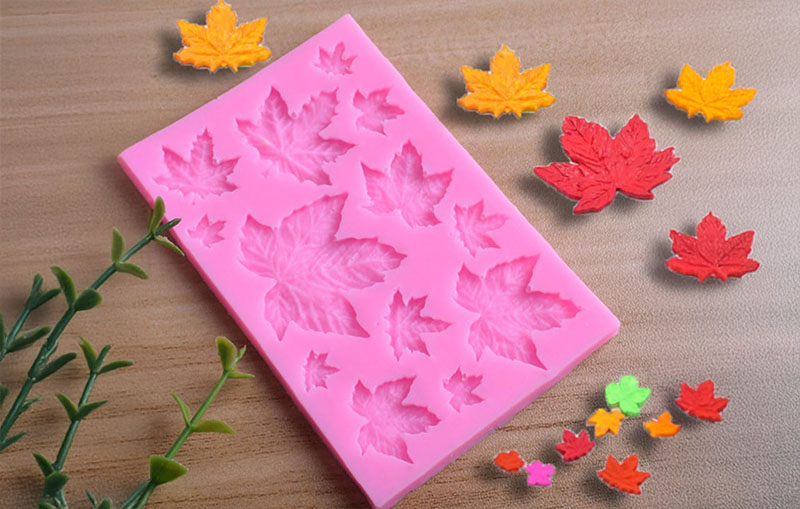
5. Use High-Quality Molds
It might sound obvious, but investing in a high-quality silicone mold can make a world of difference. Good molds are smoother, less likely to grip the clay, and they hold up better over time. I’ll expand more on this in the next section.
Best Silicone Molds for Clay
The right silicone mold can make all the difference in how detailed and professional your pieces turn out. But with so many options out there, how do you know which ones are actually worth it?
I’ve rounded up some of my favorite silicone molds that work beautifully with clay—no matter what you’re creating.
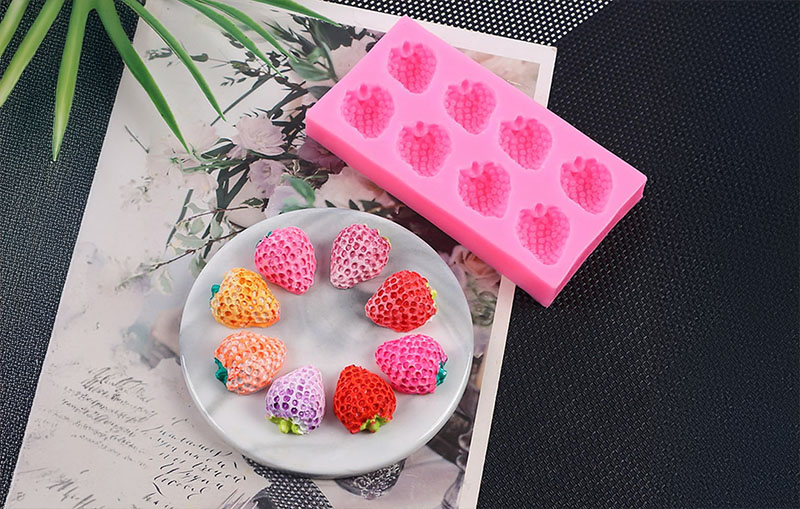
1. Flexible Molds for Intricate Designs
When you’re working on pieces that need to show off all those tiny details—think flowers, lace patterns, or little figurines—you need a mold that’s both flexible and durable.
Look for platinum-cured silicone molds that are soft enough to bend without losing their shape.
Molds from brands like MoldFun or Let’s Resin are perfect for this. They’re super pliable and can handle all those delicate touches without tearing your clay or losing definition.
- SAFE FOOD-GRADE MATERIAL – The bee silicone molds are made from premium food-grade silicone material. They are non-stick, easy to pop out, flexible, reusable, and durable. Temperature resistant from…
- WELL-DESIGNED AND MULTIPURPOSE – The fine design and the clear details make your works vivid and lively. And it is microwave, oven, refrigerator, freezer safe. You can create your own special soaps,…
- SAFE FOOD-GRADE MATERIAL : The apple silicone molds are made from premium food-grade silicone material. They are non-stick, easy to pop out, flexible, reusable, and durable. Temperature resistant from…
- WELL-DESIGNED AND MULTIPURPOSE – The fine design and the clear texture make your works vivid and lively. And it is microwave, oven, refrigerator, freezer safe. You can create your own special…
- SAFE FOOD-GRADE MATERIAL – The molds are made from high-quality food-grade TPR and PP. They are non-stick, easy to pop out, reusable, and durable.
- WELL-DESIGNED AND MULTIPURPOSE – The fine design and the clear texture make your works vivid and lively. And it is microwave, oven, refrigerator, freezer safe. You can create your own special…
- Made by food grade silicone, flexible and non-stick, smooth and soft, easy to be molded, durable and reusable, suitable for -40 to 230 Celsius degrees.
- Widely used with a variety of mediums, gum-paste, chocolate, cooked sugar, fondant, fudge, ice, butter, jelly, marzipan, bread dough, candy clay, gummy candy, gelatin, icing, ice cream, soap, candle…
2. Deep Cavity Molds for Chunkier Pieces
If you’re working on something with a little more substance—like pendants, charms, or small sculptural pieces—deep cavity molds are a must.
They give you more room to press in your clay without worrying about thin spots or breakage. Sculpey and AMACO offer some fantastic options here that are perfect for jewelry makers or anyone looking to make more solid, durable pieces.
3. Texture Sheets for Adding Patterns
Okay, technically not molds, but texture sheets deserve a shout-out because they’re so versatile!
These silicone sheets are great for adding patterns or textures to the surface of your clay before pressing it into a mold.
You can create anything from woodgrain to floral textures, and it adds that extra “wow” factor to your finished piece. Marvelous Molds has a great range of texture sheets, and they’re easy to clean and reuse.
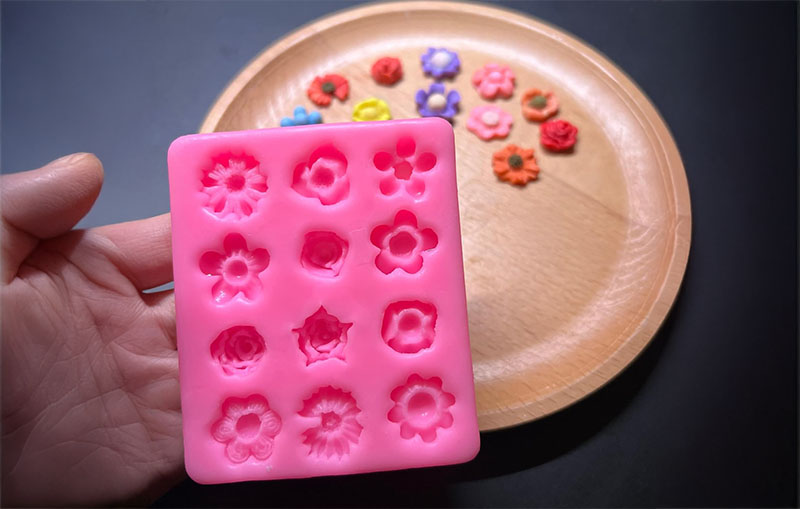
4. Food-Grade Molds (Yes, Really!)
Don’t sleep on food-grade silicone molds! These are amazing for creating clay pieces with detailed shapes, especially if you’re into making clay desserts, charms, or miniature food replicas.
Because they’re designed for candy and baking, they’re super smooth and flexible, making it easy to get your clay pieces out without a hitch.
Brands like Wilton and Silikomart have some surprisingly useful molds that work great with clay—plus, they’re easy to find at most craft or kitchen stores.
- The mould is provided with a revolutionary internal border which gives a lightly rounded shape to the base of your preparations.
- Made from LSR liquid silicone
- 8 cavities, each 2.6 inch diameter x 1.2 inch high (65mm diameter x 30mm high)
- Each cavity 2.9 ounces (85 milliliters)
- 1-silicone mold makes 8 large cube shapes, 2″x2″x2″; made from platinum based liquid (lsr) 100-percent food-grade silicone
- Silicone injected molds allow for greater details, flexibility, longer wear
- 1-silicone mold makes 6 semi-sphere shapes, 2.7 inch diameter; made from platinum based liquid (lsr) 100-percent food-grade silicone
- Silicone injected molds allow for greater details, flexibility, longer wear
Custom Silicone Molds for Clay
Feeling extra creative? Why not make your own custom mold? This way, you can capture a unique design that you won’t find anywhere else.
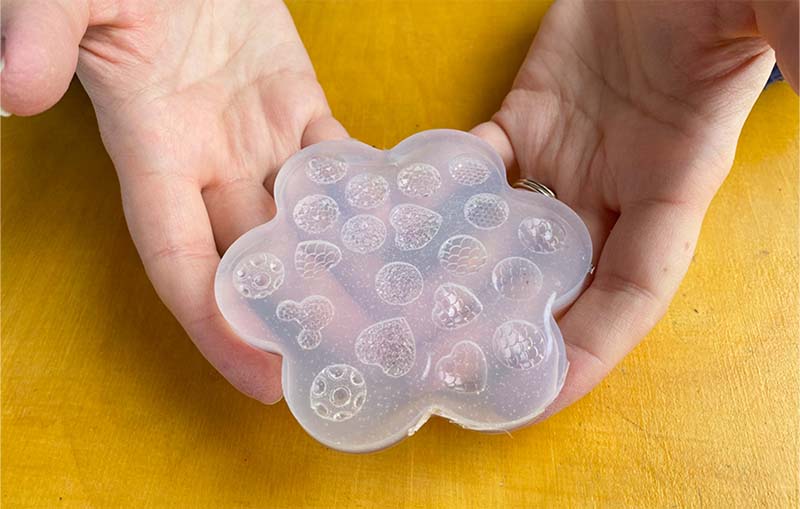
All you need is a silicone mold-making kit—brands like Alumilite and Smooth-On make some of the best ones out there. You can use these kits to make molds of small objects, existing sculptures, or even pressed flowers.
It’s a bit more work up front, but you’ll end up with a mold that’s totally one-of-a-kind!
Budget-Friendly Molds for Beginners
If you’re just starting out and want to keep things simple, look for silicone molds that are affordable but still flexible. Happy Chef Craft Supplies and Funshowcase have some great options that won’t break the bank.
They’re perfect for trying out new designs without making a big investment, and they’re usually available on Amazon or Etsy.















